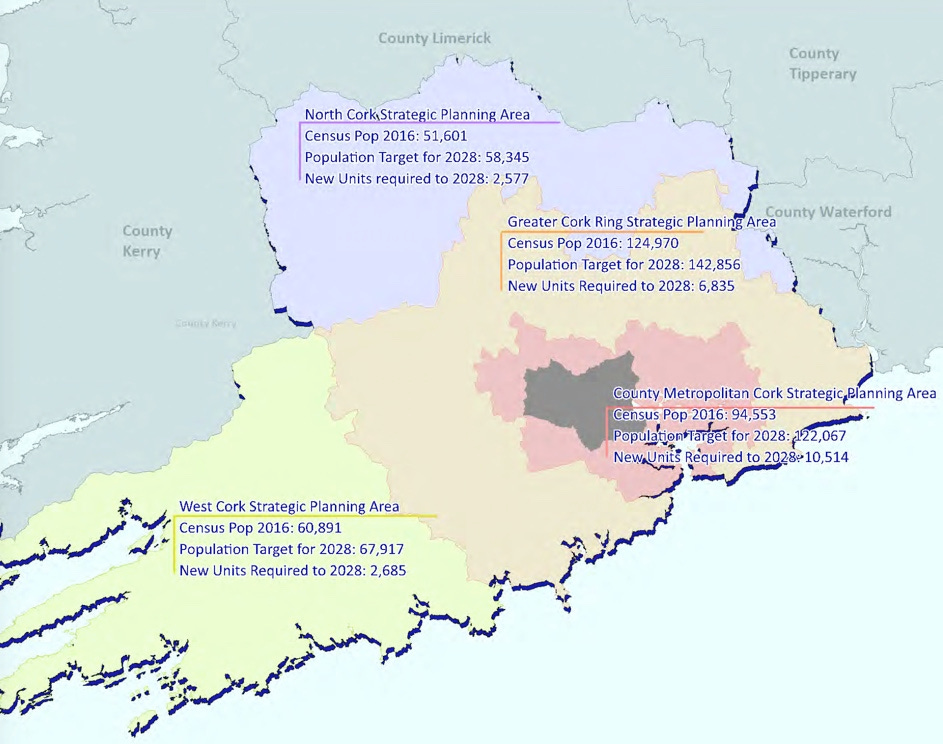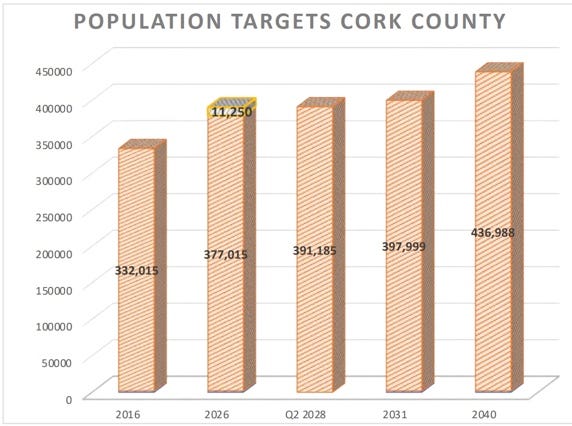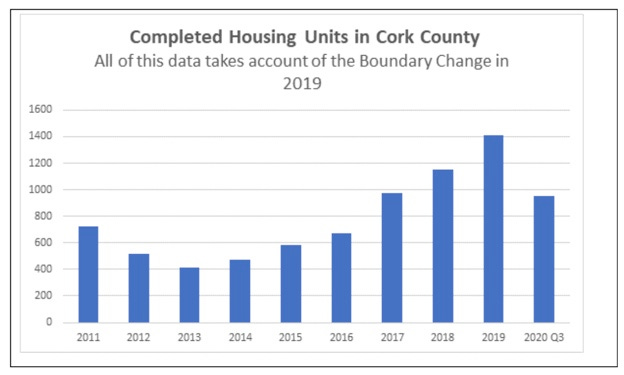Cork County Development Plan 2028: what's in it?
22,000 new homes and a population increase of 60,000 in the next six years, with big changes for Mallow and Clonakilty: part one of our two-part series on the newly adopted county development plan.

Six volumes, 750,000 words....we’re reading it so you don't have to.
Cork County Development Plan 2022-2028 came into effect on June 6.
The massive document outlines the future quality of life for the people and towns of Cork County up until 2028, and the future of the county’s biodiversity and environmental challenges too.
So Tripe + Drisheen are doing a two-part series on what’s in CCDP 2028. This week, expect a breakdown of the key take-aways from the six-volume plan: if you want to dive in yourself, or if you’re interested in what’s planned for your own area, the entire CCDP is available here.
The regions are divided into North Cork, South Cork and West Cork, with a volume on each area.
Population growth
A target of a 17% population increase countywide within the next six years, centred around key towns where the population increase could be up to 34%, is the first big item in the new development plan.
This is in line with the National Planning Framework’s Ireland 2040 plan to increase the national population by 1 million by 2040.
There are currently an estimated 333,000 people living in Cork County and the county development plan sets a target of 391,185, or just under 60,000, additional population in six years’ time.
35,500 jobs
Given that the birth rate doesn’t support such a population growth - Cork County averages around 5,000 births and 2,600 deaths per year according to the CSO - it’s unclear how and why this additional population will choose to settle in Cork County in the coming six years, but it’s clear that employment opportunity is seen both as a factor in attracting new county residents and a result of population growth.
The Regional Spatial and Economic Strategy jobs target for the plan period is for an overall growth of 35,502 jobs; given that there were 118,146 jobs in the county in 2016 according to the census, this is significant growth.
The ticking clock: 22,000 extra housing units in six years?
Of course, 17% more people in just six years puts significant pressure on housing, and arguably on all services: 17% more people means 17% more more waste, more water usage, more crime, more vulnerable people in need of services, more health, transportation and educational needs.
But housing certainly seems to be the single issue with the biggest ticking clock over it.
22,000 more housing units county-wide would need to be completed within the next six years to accommodate the targeted population increase. It’s planned that housing density be increased by locating new housing developments in Metropolitan areas like Carrigaline, Carrigtwohill, Cobh, Passage West and Midleton as well as creating an entire new town at Monard Strategic Development Zone near Blarney, where 1,443 housing units are planned.
Clonakilty and Mallow have also been identified as “key towns” for expansion, with population increases of 30% expected. “Key Villages” are also identified as being those with a population of more than 1,500.
16,453 housing units is the target for these key areas.
Little mention is made of how to bring the county’s 9,400 vacant properties back on-stream apart from upping vacant levy collection rates.
10% of the new homes need to be social housing and 10% affordable housing under the government’s Housing For All scheme, and given the county’s ageing population, a proportion of this housing must also be designed to be age-friendly and suited to people with restricted mobility or dependency needs.
Can all this be done?
Under 6,000 housing units from 2014-2019
Given that under 6,000 housing units were completed in Cork County in the preceding six year period up until the end of 2019 (excluding 2020 and 2021 due to the confounding factor of Covid), at the very least, the county is set for a construction scramble the likes of which we haven’t seen since the seventies.
Given the series of scandals currently rocking An Bórd Pleanála, the logistics of six-year turnaround on this scale of development seems worth examining further.
Water
Drinking water supply and water treatment in Cork County will be put under significant pressure by these plans. Cork County water services are already under pressure. A 2020 EPA report identified that towns including Cobh, Courtmacsherry, Dunmanway, Mitchelstown, Ringaskiddy, and Skibbereen were all failing to meet basic EU waste water treatment standards as is, with Cobh still discharging raw effluent into the sea.
The report slammed the speed of Irish Water’s response to these issues, saying Irish Water had “repeatedly revised its plans and extended the timeframe to provide treatment for towns and villages discharging untreated waste water.”
Yet in six years, not only will Irish Water need to have solved all the existing issues, but will also need to ensure supply and provision of treatment services to towns that in some instances will have grown by one third.
Cobh has a targeted growth of 30% and it’s still discharging effluent into the sea.
Mallow’s “inadequate sewage infrastructure” has been spilling sewage into the Blackwater for years although repairs are currently underway.
Tripe + Drisheen have posed the below questions to Irish Water and in part two we hope to publish their responses:
- In terms of drinking water supply, is there an additional 17% available county-wide?
- In an EPA report in 2020, Cobh was identified as a town that was still discharging raw sewage into the sea. Given that Cobh is now identified as a key town for growth
with a targeted population increase of 30%, when can Irish Water guarantee that a) the current sewage will be treated and b) that the new treatment plant will have capacity for an additional 30%?
- North Cork and the Blackwater catchment have multiple issues in Fermoy, Mitchelstown and Mallow. Mallow was identified as a town where "improvements are needed to the collection system" for sewage according to EPA 2020. Mallow is also identified as a Key Town in the CCDP: Last March it was reported that a €14 million project to upgrade Mallow's sewage system was due to start in April 2021 and would take two years: is this project on track to be completed within the original timeframe and will it be capable of handling an additional 30% capacity?
-"The Clonakilty Water Supply is at its limit and the watermain network is poor. The provision of new source is required, and Irish Water are currently considering a number of options in this regard” according to the CCDP document. Will the provision of a new water source for Clonakilty be undertaken within the next six years?
Where to, all the rubbish?
Although a population increase of 17% would result in a domestic waste increase of 17%, even if you leave aside the building waste that the provision of an additional 22,000 homes over six years would create, CCDP limits its mention of waste to a subsection in the environment chapter, rather than a separate chapter of its own.
The creation of nearly one fifth more waste county-wide is addressed in two and half pages of the first 564 page volume of the six-volume CCDP.
As Tripe + Drisheen reported last winter, the Port of Cork is exporting over 200,000 tonnes of waste per year from private contractors, with 82,295 tonnes of municipal waste destined for incineration in Sweden and the Netherlands on this list in 2020, before the rise in plastics that Covid has brought:
Mention is made of the national “Waste Action Plan for a Circular Economy,” a target of reducing municipal waste by 1% per annum, and repair and reuse initiatives including….Repair Cafés. A target of 50% recycling by 2030 does not address the issues raised in the above article, namely that most “recycling” is not being recycled and what is being exported is heading to countries where the end processes for the putative feedstock remain largely unknown.
It seems the plan is for private waste contractors to pick up the slack, but given the difficulties in even locating these facilities somewhere, how this additional load would be dealt with is unclear in this document.
The only indications of interest that the council may aim to tackle the issue on a larger scale are:
“The provision of strategic large scale waste treatment facilities to support the aims of the European Green Deal and National Policy will be considered in ‘Industrial Areas’”
And a reference to waste to energy (ie incineration) in Bottlehill in North Cork: “Bottlehill could be reconfigured to meet other waste management infrastructural needs to deliver the aims of the Circular Economy Action Plan with scope for a specialised role in the area of integrated waste management and waste to energy.”
Transport, heritage, and the challenges faced by different county regions
In part two of this series next week, we’ll be diving into some of the questions raised this week, looking at transport plans for the county, heritage and other areas, and we’ll be talking to local councillors about the challenges faced by North Cork, South Cork and West Cork.
We need your help! If you have areas you are interested in, or if you made a submission to the plan or have comments, we’d love to hear from you. You can leave a comment here, contact us on twitter or drop a line to the emails in the about page.







The census results have the population at 360k already. So they had underestimated the population by 30k and are already halfway to their 6 year goal in 1 month.